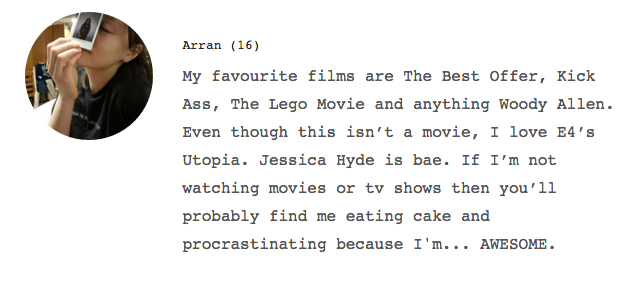SPOILER ALERT: If you haven’t read or watched Never Let Me Go and you’re not about the spoiler’s life then not to fear! This article will be great once you’ve finished the novel and/ or film.
I’m going to start off by saying that I don’t like nursing homes. No, really. I fucking hate them. And yeah, it’s probably not the most unusual or controversial of opinions, but there it is. I don’t know whether it’s the old age or a reminder of my future. Or the fact that it always reeks of decay and old memories.
These people who were once as bright and shiny as all of my friends, who had countless opportunities and experiences waiting for them are now met with a husk of a body and exceedingly withered faculties.
So you can imagine my enthusiasm when my Mum asked me to see my Grandfather, dementia patient of 16 years, in the nursing home. I’d just finished, for the second time, Kazuo Ishiguro’s Never Let Me Go. The first time I recalled not being particularly moved by the novel, or more aptly, refusing to feel any strong emotions in fear of repeating the episode I experienced in 2010 after watching the film. I don’t know exactly where I first heard about it but as a reasonably shallow 10-year-old I decided that Keira Knightley was pretty and I had to see the film. Much to my surprise it wasn’t a quirky little love triangle, but a harrowing dystopian movie which led to my despondently moping about the house for hours past my bedtime.
Upon reading it for the second time I realised how greatly I had originally misinterpreted the story. For those who aren’t aware of the premise, the backdrop is a dystopian version of England which creates clones who donate their organs, resulting in a lifespan of approximately thirty years. We follow the lives of three “donors”: Tommy, Kathy and Ruth, played by Andrew Garfield, Carey Mulligan and Keira Knightley, respectively. The three enter into a love triangle, with Ruth, Kathy’s best friend, dating the love of the former’s life, Tommy. In an hour and forty-three minutes I had decided that whatever world they were living in, it wasn’t mine and was outraged by the injustice of the cruel oppressor’s within this fictional universe.
Thoughts and questions circulated in my mind for years after the first watch and eventual read of Never Let Me Go. The one on the forefront of my mind was, why didn’t they do anything? Why didn’t they run away, or even really express their utter distress? And only after the second read and a look at some of Ishiguro’s interviews I realised that was kind of the point. They didn’t run away, because in real-life-bad-situations we rarely do. We rarely dissent nor do we try and escape the inevitable. In Ishiguro’s words in most terrible state of affairs “we don’t have the perspective to think of running away.”
Admittedly this was a far more profound reading of the story. Before, I wasn’t much taken by the overall novel and I felt a little betrayed by how unremitting the film was. Although I wasn’t less heartbroken the second time around, I realised that there was a far more tangible connection to the real world. And this was the general consensus with all of the people a part of the 2010 film. I was pleased to find that the director (Mark Romanek), screenplay writer (Alex Garland), actors and essentially everyone on board the movie was invested in creating Ishiguro’s message. In an interview with Mulligan, Garfield interpreted it to be “a story about denial… and the things you have to do to not be constantly raging and screaming and lie down in bed and wait for death to come.” To me, this was a perfect summary of the novel.
Back to the nursing home and my Mum’s request, I recalled Garfield’s words and it made me profoundly unsettled. I guess the main reason was because it’s a profoundly unsettling thought that we don’t do much when faced with awful scenarios. In reality, we go to the nursing home, we sit down and we smile. We don’t think about crying much, because what good would that do? This was also Kathy’s mantra. She would be defined as a pretty “strong” person. She’s pragmatic and stoic, making her a good carer. Tommy is meant to juxtapose this. As a child in Hailsham – the boarding school style home the main characters were raised in – he is constantly having temper tantrums and is unable to control himself. As he “matures”, stoicism sets in and the rage is suppressed. Hailsham has a significant role in this as it is “…a concrete metaphor for childhood and youth,” in the author’s own words.
As they were mentioning Hailsham within the interviews I kept on thinking about a quote within both the book and the film, where one of the guardians, Ms. Lucy states to the children that “You’ve been told and not told.” This is strikingly similar to death as a child. You’re aware of the fact that it happens but you’re never keenly aware of the ins and outs of it as a young person. The growing awareness of mortality is a part of the push to grow up and become an adult. This happens in the real world as people, especially my friends, throw around this phrase “existential angst”. We’re always talking about that moment when you’re like “Oh, shit. I’m gonna die one day.” And every time I have ever mentioned this to a friend or them to myself they’ve always looked at me solemnly and in an understanding way and said “Yeah. That happened to me as well.” And a sympathetic hand is put on a knee and we move onto the next point of conversation.
Like all of the story, each sequence and each circumstance is such a perfect metaphor for something within our own society. Garland, a long-time friend of Ishiguro seemed keenly aware of this as he stated “it was all about real stuff,” as the characters “… have basically the same experience” as us people in the real world. Something I also really liked about the screen writer’s interpretation of the novel was that he discussed how it was broken up into three parts: “[the] first third is set in a school and the second third is in the Cottages and the third is set in essentially hospitals.” Sounds familiar? Because this is basically how most of us go about our lives. Okay, maybe not so much the Cottages but a version of the Cottages exists for everyone. That space when you’re a young adult figuring out the world for the first time and then being met with the adult world, paralleled by the experience of being a carer and finally “donating” or in our own experiences, carking it in a nursing home somewhere.
And going into the movie the second time I really wanted to be pleased with it and love it as much as all the cast and crew seemed to. But coming out of it I was sort of baffled about how little of the original themes I loved in the novel were in the film. After reading Never Let Me Go the first time I really wasn’t angry at the adaptation. It seemed pretty accurate. Watching it again, however I just felt like all of the character’s with the exception of Tommy and the guardians were shallow husks of the originals. The character that irked me the most in its translation from page to screen was Ruth. She wasn’t an awful person in either mediums but something about her and Kathy’s relationship was completely lost. The unyielding, strong love and especially adoration the two girls had for one another didn’t come through to me.
As I was writing notes for the movie this point that Mulligan brought up a couple of times stuck in my mind. She recalled one particular moment in the book where Tommy right at the end tells Kathy that they’re like “…two people in the water, trying to hold onto each other… but in the end it’s just too much… They’ve got to let go.” This stuck out to her as “it was this epic love story reduced to (shrugs shoulders) ‘it’s a shame’… and that was so powerful.” This epitomised how I felt the movie was interpreted as a lot of the moments that were reduced or ones that were copied almost verbatim from the original were decisions around the romance between the two main characters.
Large portions of their childhood such as the games Ruth used to conduct were taken out or shortened drastically. There was also a scene in the film at the Cottages where Ruth tells Kath essentially, to back off. Although a scene similar to this happened in the book it was something that made more sense and was a less balls-y move on Ruth’s part. Instead of confronting her about her true feelings she just states in a friendly sort of manner that Tommy wouldn’t be interested in a girl who has had too many sexual partners. This was also accompanied by many prior private talks about sex and other young-adult-angst. The fact that all of these other talks had been taken out or not at the very least mentioned resulted an almost out of character and bizarre confrontation that appeared to be just to drive the plot forward.
Honestly, I didn’t hate the movie. I really didn’t. It had an amazing aesthetic that I thought fit extremely well with the book and all the actors were well cast, making perfect visual sense with the original characters. The transition from screen to page is a difficult one to make and in practicality, the essence is the only true thing that can be captured in such a short time. To me the essence was almost perfect but fell a little short. But maybe I was just so invested in my own interpretation of Never Let Me Go that it’s difficult to embrace any other.
Coming back to the nursing home, my Mum and the decision of whether or not to go visit my grandfather, I also recalled reading out some of my favourite lines from the book to a good friend recently. She pointed out that it was strikingly similar to how someone at the end of their life looks back fondly at past memories. Still profoundly unsettled by this concept of acceptance in awful times I wondered whether it really was so good that Kathy had resigned herself to her fate.
Is it ever good to resign ourselves to an unpleasant fate? I quickly recalled those times at the home. That awful smell. The way all the patients wandered around in an absent-minded trance not being able to remember a new name let alone a new experience. And especially, I recalled my grandfather. I thought back to those times that he’d struggle against his restraints on the bed and how his eyes would casually drift from person to person almost as if he would start a conversation. He never would though. It wouldn’t be able to go past a few short-lived stutters. A few years back he said to me he was getting better. I thought about this and I was closed to crying and of course he wasn’t getting better and –
So was I going to visit? Sighing, I looked up at my Mum. Impatient, she asked for the last time. So as a good granddaughter does, I got up from my seat and got on with it.
Research:
https://www.youtube.com/watch?v=qaAeXlQcn2k
https://www.youtube.com/watch?v=mb_BmKVFqrQ
https://www.youtube.com/watch?v=o7Es5-nhZWo
https://www.youtube.com/watch?v=t_gRhJ_Rwhg

